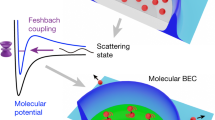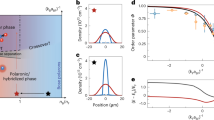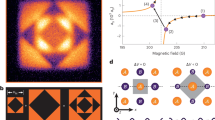Abstract
The realization of superfluidity in a dilute gas of fermionic atoms, analogous to superconductivity in metals, represents a long-standing goal of ultracold gas research. In such a fermionic superfluid, it should be possible to adjust the interaction strength and tune the system continuously between two limits: a Bardeen–Cooper–Schrieffer (BCS)-type superfluid (involving correlated atom pairs in momentum space) and a Bose–Einstein condensate (BEC), in which spatially local pairs of atoms are bound together. This crossover between BCS-type superfluidity and the BEC limit has long been of theoretical interest, motivated in part by the discovery of high-temperature superconductors1,2,3,4,5,6,7,8,9,10. In atomic Fermi gas experiments superfluidity has not yet been demonstrated; however, long-lived molecules consisting of locally paired fermions have been reversibly created11,12,13,14,13. Here we report the direct observation of a molecular Bose–Einstein condensate created solely by adjusting the interaction strength in an ultracold Fermi gas of atoms. This state of matter represents one extreme of the predicted BCS–BEC continuum.
This is a preview of subscription content, access via your institution
Access options
Subscribe to this journal
Receive 51 print issues and online access
$199.00 per year
only $3.90 per issue
Buy this article
- Purchase on Springer Link
- Instant access to full article PDF
Prices may be subject to local taxes which are calculated during checkout





Similar content being viewed by others
References
Leggett, A. J. Cooper pairing in spin-polarized Fermi systems. J. Phys. C (Paris) 41, 7–19 (1980)
Nozieres, P. & Schmitt-Rink, S. Bose condensation in an attractive fermion gas: From weak to strong coupling superconductivity. J. Low-Temp. Phys. 59, 195–211 (1985)
Drechsler, M. & Zwerger, W. Crossover from BCS-superconductivity to Bose-condensation. Ann. Phys. 1, 15–23 (1992)
Haussmann, R. Properties of a Fermi-liquid at the superfluid transition in the crossover region between BCS superconductivity and Bose-Einstein condensation. Phys. Rev. B 49, 12975–12983 (1994)
Randeria, M. in Bose-Einstein Condensation (eds Griffin, A., Snoke, D. W. & Stringari, S.) 355–392 (Cambridge Univ. Press, Cambridge, UK, 1995)
Holland, M., Kokkelmans, S., Chiofalo, M. L. & Walser, R. Resonance superfluidity in a quantum degenerate Fermi gas. Phys. Rev. Lett. 87, 120406 (2001)
Timmermans, E., Furuya, K., Milonni, P. W. & Kerman, A. K. Prospect of creating a composite Fermi-Bose superfluid. Phys. Lett. 285, 228–233 (2001)
Ohashi, Y. & Griffin, A. BCS-BEC crossover in a gas of Fermi atoms with a Feshbach resonance. Phys. Rev. Lett. 89, 130402 (2002)
Milstein, J. N., Kokkelmans, S. & Holland, M. J. Resonance theory of the crossover from Bardeen-Cooper-Schrieffer superfluidity to Bose-Einstein condensation in a dilute Fermi gas. Phys. Rev. A 66, 043604 (2002)
Ohashi, Y. & Griffin, A. Superfluid transition temperature in a trapped gas of Fermi atoms with a Feshbach resonance. Phys. Rev. A 67, 033603 (2003)
Regal, C. A., Ticknor, C., Bohn, J. L. & Jin, D. S. Creation of ultracold molecules from a Fermi gas of atoms. Nature 424, 47–50 (2003)
Strecker, K. E., Partridge, G. B. & Hulet, R. G. Conversion of an atomic Fermi gas to a long-lived molecular Bose gas. Phys. Rev. Lett. 91 (2003)
Cubizolles, J., Bourdel, T., Kokkelmans, S. J. J. M. F., Shlyapnikov, G. V., Salomon, C. Production of long-lived ultracold Li2 molecules from a Fermi gas. Preprint at 〈http://arXiv.org/cond-mat/0308018〉 (2003).
Jochim, S. et al. Pure gas of optically trapped molecules created from fermionic atoms. Preprint at 〈http://arXiv.org/cond-mat/0308095〉 (2003).
Regal, C. A., Greiner, M., & Jin, D. S. Lifetime of molecule-atom mixtures near a Feshbach resonance in 40K. Preprint at 〈http://arXiv.org/cond-mat/0308606〉 (2003).
Carr, L. D., Shlyapnikov, G. V. & Castin, Y. Achieving a BCS transition in an atomic Fermi gas. Preprint at 〈http://arXiv.org/cond-mat/0308306〉 (2003).
DeMarco, B. & Jin, D. S. Onset of Fermi degeneracy in a trapped atomic gas. Science 285, 1703–1706 (1999)
Regal, C. A. & Jin, D. S. Measurement of positive and negative scattering lengths in a Fermi gas of atoms. Phys. Rev. Lett. 90, 230404 (2003)
Stwalley, W. C. Stability of spin-aligned hydrogen at low temperatures and high magnetic fields: New field-dependent scattering resonances and predissociations. Phys. Rev. Lett. 37, 1628–1631 (1976)
Donley, E. A., Claussen, N. R., Thompson, S. T. & Wieman, C. E. Atom-molecule coherence in a Bose-Einstein condensate. Nature 417, 529–533 (2002)
Chin, C., Kerman, A. J., Vuletic, V. & Chu, S. Sensitive detection of cold cesium molecules formed on Feshbach resonances. Phys. Rev. Lett. 033201 (2003)
Herbig, J. et al. Preparation of a pure molecular quantum gas. Science 301, 1510–1513 (2003)
Durr, S., Volz, T., Marte, A. & Rempe, G. Observation of molecules produced from a Bose-Einstein condensate. Preprint at 〈http://arXiv.org/cond-mat/0307440〉 (2003).
Xu, K. et al. Formation of quantum-degenerate sodium molecules. Preprint at 〈http://arXiv.org/cond-mat/0310027〉 (2003).
Loftus, T., Regal, C. A., Ticknor, C., Bohn, J. L. & Jin, D. S. Resonant control of elastic collisions in an optically trapped Fermi gas of atoms. Phys. Rev. Lett. 88, 173201 (2002)
Ratcliff, L. B., Fish, J. L. & Konowalow, D. D. Electronic transition dipole moment functions for transitions among the twenty-six lowest-lying states of Li2 . J. Mol. Spectrosc. 122, 293–312 (1987)
Petrov, D. S., Salomon, C. & Shlyapnikov, G. V. Weakly bound dimers of fermionic atoms. Preprint at 〈http://arXiv.org/cond-mat/0309010〉 (2003).
Shvarchuck, I. et al. Bose-Einstein condensation into non-equilibrium states studied by condensate focusing. Phys. Rev. Lett. 89, 270–404 (2002)
Anderson, M. H., Ensher, J. R., Matthews, M. R., Wieman, C. E. & Cornell, E. A. Observation of Bose-Einstein condensation in a dilute atomic vapor. Science 269, 198–201 (1995)
Davis, K. B. et al. Bose-Einstein condensation in a gas of sodium atoms. Phys. Rev. Lett. 75, 3969–3973 (1995)
Bradley, C. C., Sackett, C. A. & Hulet, R. G. Bose-Einstein condensation of lithium: observation of limited condensate number. Phys. Rev. Lett. 78, 985–989 (1997)
Giorgini, S., Pitaevskii, L. P. & Stringari, S. Condensate fraction and critical temperature of a trapped interacting Bose gas. Phys. Rev. A 54, R4633–R4636 (1996)
Acknowledgements
We thank L. D. Carr, E. A. Cornell, C. E. Wieman, W. Zwerger and I. Bloch for discussions, and J. Smith for experimental assistance. This work was supported by NSF and NIST. C.A.R. acknowledges support from the Hertz Foundation.
Author information
Authors and Affiliations
Corresponding author
Ethics declarations
Competing interests
The authors declare that they have no competing financial interests.
Rights and permissions
About this article
Cite this article
Greiner, M., Regal, C. & Jin, D. Emergence of a molecular Bose–Einstein condensate from a Fermi gas. Nature 426, 537–540 (2003). https://doi.org/10.1038/nature02199
Received:
Accepted:
Published:
Issue Date:
DOI: https://doi.org/10.1038/nature02199
This article is cited by
-
A quantum engine in the BEC–BCS crossover
Nature (2023)
-
Field-linked resonances of polar molecules
Nature (2023)
-
Exploring the Transition from BCS to Unitarity Using Normal Modes: Energies, Entropies, Critical Temperatures and Excitation Frequencies
Journal of Low Temperature Physics (2023)
-
Observation of Bose-Einstein condensates of excitons in a bulk semiconductor
Nature Communications (2022)
-
Quantization of interacting Galilean field theories
Journal of High Energy Physics (2022)
Comments
By submitting a comment you agree to abide by our Terms and Community Guidelines. If you find something abusive or that does not comply with our terms or guidelines please flag it as inappropriate.



